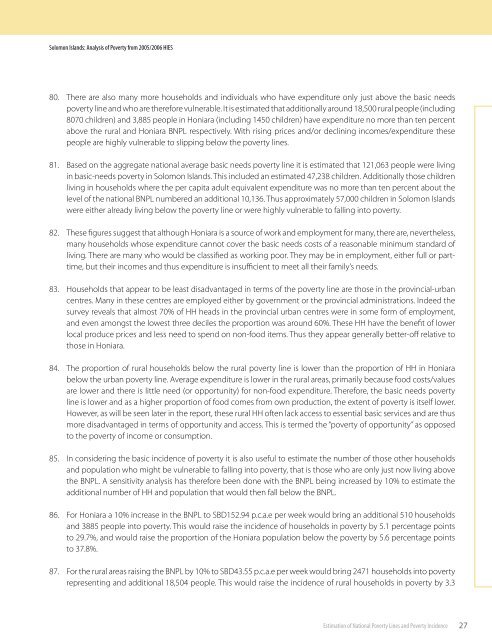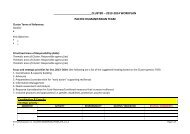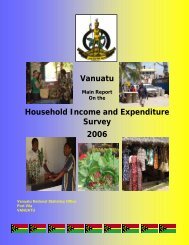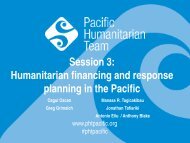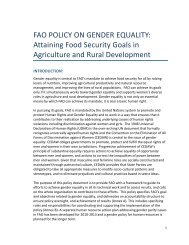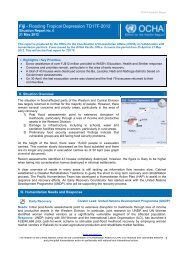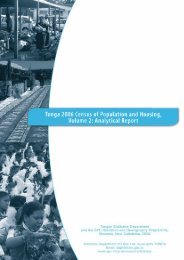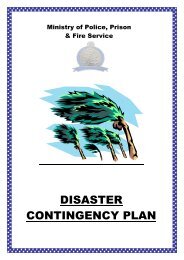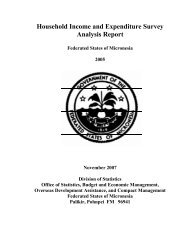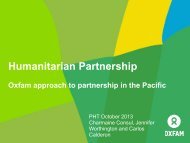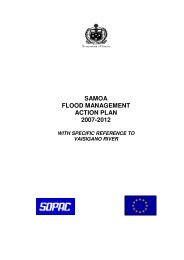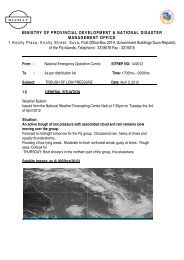Solomon Islands - Asia & the Pacific
Solomon Islands - Asia & the Pacific
Solomon Islands - Asia & the Pacific
Create successful ePaper yourself
Turn your PDF publications into a flip-book with our unique Google optimized e-Paper software.
<strong>Solomon</strong> <strong>Islands</strong>: Analysis of Poverty from 2005/2006 HIES80. There are also many more households and individuals who have expenditure only just above <strong>the</strong> basic needspoverty line and who are <strong>the</strong>refore vulnerable. It is estimated that additionally around 18,500 rural people (including8070 children) and 3,885 people in Honiara (including 1450 children) have expenditure no more than ten percentabove <strong>the</strong> rural and Honiara BNPL respectively. With rising prices and/or declining incomes/expenditure <strong>the</strong>sepeople are highly vulnerable to slipping below <strong>the</strong> poverty lines.81. Based on <strong>the</strong> aggregate national average basic needs poverty line it is estimated that 121,063 people were livingin basic-needs poverty in <strong>Solomon</strong> <strong>Islands</strong>. This included an estimated 47,238 children. Additionally those childrenliving in households where <strong>the</strong> per capita adult equivalent expenditure was no more than ten percent about <strong>the</strong>level of <strong>the</strong> national BNPL numbered an additional 10,136. Thus approximately 57,000 children in <strong>Solomon</strong> <strong>Islands</strong>were ei<strong>the</strong>r already living below <strong>the</strong> poverty line or were highly vulnerable to falling into poverty.82. These figures suggest that although Honiara is a source of work and employment for many, <strong>the</strong>re are, never<strong>the</strong>less,many households whose expenditure cannot cover <strong>the</strong> basic needs costs of a reasonable minimum standard ofliving. There are many who would be classified as working poor. They may be in employment, ei<strong>the</strong>r full or parttime,but <strong>the</strong>ir incomes and thus expenditure is insufficient to meet all <strong>the</strong>ir family’s needs.83. Households that appear to be least disadvantaged in terms of <strong>the</strong> poverty line are those in <strong>the</strong> provincial-urbancentres. Many in <strong>the</strong>se centres are employed ei<strong>the</strong>r by government or <strong>the</strong> provincial administrations. Indeed <strong>the</strong>survey reveals that almost 70% of HH heads in <strong>the</strong> provincial urban centres were in some form of employment,and even amongst <strong>the</strong> lowest three deciles <strong>the</strong> proportion was around 60%. These HH have <strong>the</strong> benefit of lowerlocal produce prices and less need to spend on non-food items. Thus <strong>the</strong>y appear generally better-off relative tothose in Honiara.84. The proportion of rural households below <strong>the</strong> rural poverty line is lower than <strong>the</strong> proportion of HH in Honiarabelow <strong>the</strong> urban poverty line. Average expenditure is lower in <strong>the</strong> rural areas, primarily because food costs/valuesare lower and <strong>the</strong>re is little need (or opportunity) for non-food expenditure. Therefore, <strong>the</strong> basic needs povertyline is lower and as a higher proportion of food comes from own production, <strong>the</strong> extent of poverty is itself lower.However, as will be seen later in <strong>the</strong> report, <strong>the</strong>se rural HH often lack access to essential basic services and are thusmore disadvantaged in terms of opportunity and access. This is termed <strong>the</strong> “poverty of opportunity” as opposedto <strong>the</strong> poverty of income or consumption.85. In considering <strong>the</strong> basic incidence of poverty it is also useful to estimate <strong>the</strong> number of those o<strong>the</strong>r householdsand population who might be vulnerable to falling into poverty, that is those who are only just now living above<strong>the</strong> BNPL. A sensitivity analysis has <strong>the</strong>refore been done with <strong>the</strong> BNPL being increased by 10% to estimate <strong>the</strong>additional number of HH and population that would <strong>the</strong>n fall below <strong>the</strong> BNPL.86. For Honiara a 10% increase in <strong>the</strong> BNPL to SBD152.94 p.c.a.e per week would bring an additional 510 householdsand 3885 people into poverty. This would raise <strong>the</strong> incidence of households in poverty by 5.1 percentage pointsto 29.7%, and would raise <strong>the</strong> proportion of <strong>the</strong> Honiara population below <strong>the</strong> poverty by 5.6 percentage pointsto 37.8%.87. For <strong>the</strong> rural areas raising <strong>the</strong> BNPL by 10% to SBD43.55 p.c.a.e per week would bring 2471 households into povertyrepresenting and additional 18,504 people. This would raise <strong>the</strong> incidence of rural households in poverty by 3.3Estimation of National Poverty Lines and Poverty Incidence27


